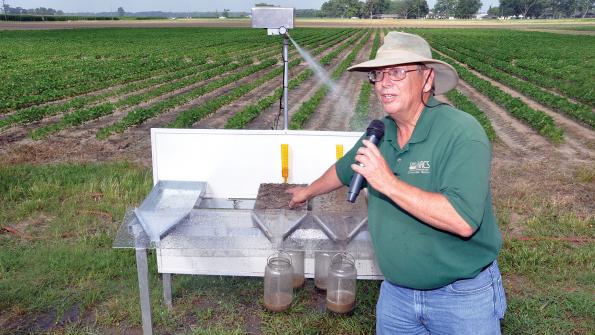
Farmers can do a lot more for their soil by keeping it covered and disturbing it less, and actually save water and fuel in the process, according to scientists with the Natural Resources Conservation Service.
Subscribe to Delta Farm Press Daily.
Steve Nipper, NRCS water quality specialist, and Joel Bolin, resource soil scientist, NRCS, provided farmers with a three-dimensional demonstration of how no-till and cover crop practices improve water infiltration significantly versus tillage without a cover crop, at the Northeast Research Station Pest Management and Crop Production Field Day in St. Joseph, La.
The scientists collected clay soils from a conventionally-tilled field and a field across the road from that location which had been no-tilled and planted with cover crops for several years. The soils were placed into pans with collection jugs positioned to catch and measure water infiltration and runoff. A spray nozzle overhead simulated rainfall.
At the end of the demonstration, almost twice as much water infiltrated the pan with the no-till/cover crop soil, while twice as much water ran off the pan containing conventionally-tilled soil.
Tilled soils can seal over
Residue was still visible on the no-till/cover-crop soil, while the conventionally-tilled soil was sealed tight, with very little water penetrating into the soil profile.
“Many farmers think that if they till the soil, water will infiltrate better because they’ve broken up the soil,” Bolin said. “But when water hits these tilled clay soils, they crust over, with water infiltration slightly better than concrete. Instead of the water penetrating, it runs off.
“In the no-till pan, the soils are not sealing over. In the no-till field, you can see where earthworms had been digging through the soil.
“Whenever you plow a soil up, you destroy what structure it had and you destroy all those pores,” Nipper said. “The first time it rains, it seals over.”
As Mid-South farmers head into the peak of irrigation season, soils with better water infiltration can be watered more efficiently and handle drought better, Nipper says.
“If you no-till it, you end up with twice as much water going into the ground. Water that ends up at the tail end of the field is useless.”
Improving soil health
In addition, water running off a conventionally-tilled field can cause sheet and rill erosion in the field, which can lead to significant soil loss and declines in soil health, according to Nipper.
Farmers can improve the health of their soils through four basic soil health principles to improve soil heath and sustainability, according to the scientists.
• Use plant diversity to increase diversity in the soil.
• Manage soils more by disturbing them less.
• Keep plants growing throughout the year to feed the soil.
• Keep the soil covered as much as possible.
A soil health management plan, which can be developed with the help of NRCS, outlines a system of practices needed to enhance crop production and soil function and improve or sustain water quality, air quality, energy efficiency and wildlife habitat.
This can be accomplished with practices like conservation crop rotation, cover crops, leaving a cover on the surface during the winter, no-till, mulching, nutrient management and pest management.
Benefits of a healthy soil
Benefits of these practices include saving energy by using less fuel for tillage. In addition, organic matter, which will build as tillage declines and plants and residue cover the soil, can hold 18 to 20 times its weight in water and recycles nutrients for plants to use. One percent of organic matter in the top six inches of soil can hold approximately 27,000 gallons of water per acre.
Cover crops help increase organic matter in the soil and improve overall soil health by adding living roots to the soil for more months of the year. Deep-rooted crops like forage radishes create natural water passages. Legume cover crops serve as natural fertilizers, while grasses scavenge nutrients that are often lost after harvest or during winter.
The scientists say these practices can also reduce disease and pest problems and improve income sustainability for farms and ranches.
When should you see results?
Most farmers can increase their soil organic matter in three to 10 years if they are motivated about adopting conservation practices to achieve this goal, according to the scientists.
Healthy soils may require fewer passes over fields because they are only minimally tilled and they aren’t over-reliant on excessive nutrient inputs to grow crops, NRCS says.
Healthy soils can also increase farmers’ profit margins by reducing labor and expenses for fuel and optimizing inputs.
How’s your sense of smell?
NRCS scientists say healthy soil has a sweet and earthy aroma, from geosmin, a byproduct of soil microbes called actinomycetes. These microbes decompose the tough plant and animal residues in and on the soil and bring nitrogen from the air into the soil to feed plants.
An unhealthy, out of balance soil smells sour or metallic, or like kitchen cleanser.
About the Author(s)
You May Also Like






